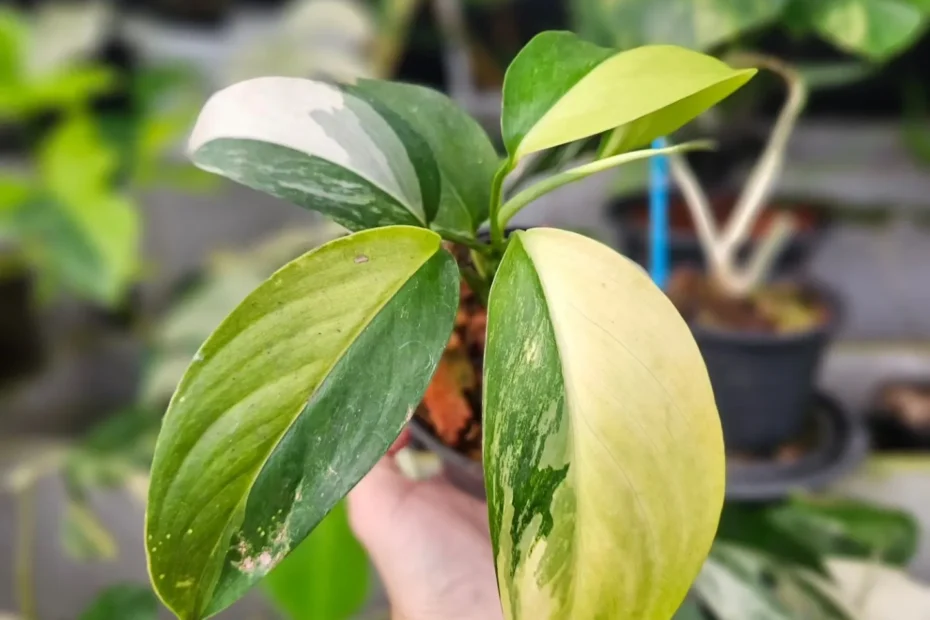Greetings, fellow plant lovers! My name is Anitha, and I’m deeply passionate about the world of Philodendrons, especially the enigmatic Philodendron White Knight. With years of hands-on experience nurturing these tropical beauties, I’ve come to appreciate their distinct presence in the plant kingdom.
The Philodendron White Knight stands out with its remarkable variegated foliage, featuring swirls of white and green that dance across each leaf like a masterpiece of nature’s own design. It’s this mesmerizing contrast that captivates anyone fortunate enough to gaze upon it, making it a coveted addition to any indoor garden. Join me as we explore the secrets of caring for this majestic plant, ensuring it thrives and continues to enchant for years to come.
Understanding the Philodendron White Knight

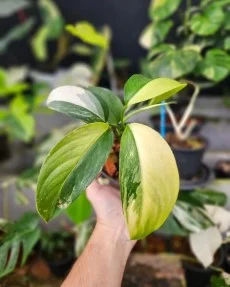
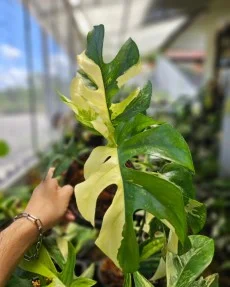
Origin and Natural Habitat
The Philodendron White Knight is believed to have originated from the tropical rainforests of South America. In these lush, moist environments, it flourishes under the canopy of tall trees, thriving in the dappled sunlight and enjoying the high humidity. This background is crucial to understand for anyone aiming to replicate the ideal conditions for their Philodendron White Knight at home.
Growth Habit and Potential Size
The Philodendron White Knight is a climbing variety, known for its potential to grow luxuriantly under the right conditions. In its natural habitat, it can climb up to the forest canopy, but indoors, with appropriate support, it can reach an impressive size of up to 3-4 feet in height and spread. Its growth habit makes it a perfect candidate for spaces where a touch of tropical splendor is desired.
Ideal Indoor Environment
To create the perfect indoor environment for your Philodendron White Knight, aim for indirect, bright light, and maintain a consistent humidity level of at least 60%. This plant prefers warm temperatures ranging from 65°F to 80°F (18°C to 26°C), mimicking the conditions of its natural tropical habitat. Regular watering, allowing the top inch of soil to dry out in between, alongside monthly fertilization during the growing season, will ensure a healthy growth.
Essential Care Requirements for a Thriving Philodendron White Knight
Light
One of the critical factors in achieving optimal growth for your Philodendron White Knight is providing it with the right amount of light. Bright, indirect light is ideal, as it closely mimics the dappled sunlight of the plant’s natural rainforest habitat. Adequate light is crucial for maintaining the plant’s vibrant variegation, supporting photosynthesis, and encouraging lush, healthy growth.
To identify ideal locations in your home, consider the orientation of your windows. North-facing windows often provide consistent but gentle light, making them suitable for your Philodendron. East-facing windows capture the mild morning sun, offering a refreshing start. West and South-facing windows can also be utilized, but you may need to diffuse the light with sheer curtains or position the plant further away to avoid the harsh afternoon sun.
Recognizing signs of insufficient or excessive light is key to adjusting your plant’s environment for its well-being. If your Philodendron White Knight’s leaves are leggy or its variegation is fading, it might not be receiving enough light. Conversely, leaves that appear scorched or faded may indicate too much direct sunlight. Observing your plant’s response and adjusting its placement accordingly will ensure it thrives in your care.
Watering
Proper watering is essential in preventing root rot, a common issue that can devastate your Philodendron White Knight. This plant prefers the soil to be slightly moist but not waterlogged. To check the soil moisture accurately, insert your finger into the soil up to the first knuckle; if the soil feels dry, it’s time to water. Alternatively, using a moisture meter can provide a more scientific assessment of the soil’s moisture level.
When it comes to watering methods, bottom watering is an effective technique that encourages roots to grow downward, promoting healthy plant development. To bottom water, place your plant in a container with water and allow the soil to absorb moisture from the bottom up until the topsoil is moist. This method reduces the likelihood of over-watering and helps prevent the top layer of soil from becoming compacted. However, it’s essential to drain any excess water to avoid soggy conditions that can lead to root rot.
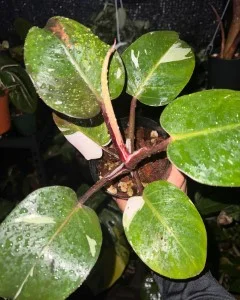
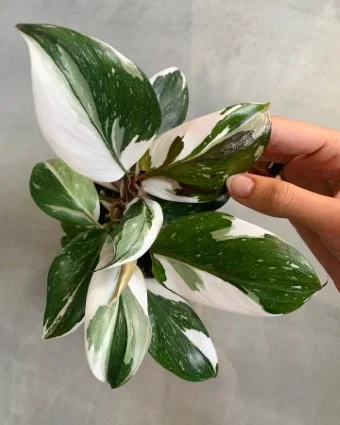
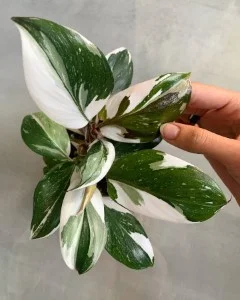
Soil and Potting
Choosing the right soil mix is critical for the health of your Philodendron White Knight, which requires a well-draining, aerated potting mix to thrive. A mixture containing peat, perlite, and orchid bark offers an ideal balance of moisture retention and drainage. Perlite increases aeration and drainage, while orchid bark adds structure and helps maintain moisture without waterlogging the roots.
When potting or repotting your plant, selecting the appropriate pot size is crucial. A pot that’s too large for the plant’s current size can hold excess moisture, increasing the risk of root rot. Generally, choose a pot that is 1-2 inches larger in diameter than the current one, ensuring your Philodendron White Knight has enough room to grow without being overwhelmed by too much soil.
Temperature and Humidity
The Philodendron White Knight thrives in warm temperatures ranging from 65°F to 80°F (18°C to 26°C), mimicking its native tropical habitat. It also benefits from moderate to high humidity levels, ideally between 60% to 80%. To achieve and maintain these humidity levels, consider using a humidifier, placing a tray of water near the plant, or grouping plants together to create a microclimate with higher moisture content. These methods help simulate the humid environment the Philodendron White Knight is accustomed to, promoting lush growth and vibrant foliage.
Fertilization
A balanced approach to fertilization during the growing season (spring through summer) supports the well-being of your Philodendron White Knight. Use a balanced, water-soluble fertilizer diluted to half the recommended strength monthly, ensuring the plant receives the necessary nutrients without the risk of chemical burn caused by over-fertilization. Over-fertilization can lead to salt buildup in the soil, potentially harming the plant’s roots and affecting its growth. Regular, careful fertilization plays a crucial role in maintaining a healthy, thriving Philodendron White Knight.
Maintaining a Flourishing Philodendron White Knight
Pruning for Healthier, Bushier Growth
Pruning your Philodendron White Knight not only encourages a bushier growth pattern but also keeps the plant healthy by removing any dead or damaged foliage. It’s best to prune in the spring or summer, during the plant’s active growth period. Use clean, sharp scissors or pruning shears to cut just above a leaf node, where the leaf attaches to the stem. This method promotes new growth from the cut area. Regularly removing a few of the oldest, largest leaves can also stimulate the plant to produce new leaves, resulting in a denser, more vibrant appearance. Always ensure your pruning tools are sterilized before use to prevent the spread of disease.
Pest and Disease Management
One of the first signs of a healthy Philodendron White Knight turning for the worse is often pest infiltration or disease manifestation. Common pests include spider mites, mealybugs, and aphids. Regularly inspect your plant for these intruders, focusing on the undersides of leaves and at leaf joints. If pests are found, gently wipe them away with a soft, damp cloth or use an organic insecticidal soap for more severe infestations. Diseases like root rot can occur due to over-watering or poor drainage. Ensure your plant’s soil is well-draining and allow the top inch of soil to dry out between waterings. Implementing these preventive measures can curb the onset of pests and diseases, keeping your plant thriving.
Repotting Based on Growth and Root Conditions
Repotting your Philodendron White Knight may be necessary every 2-3 years, or when you notice signs of the plant becoming rootbound. Indicators include roots growing out of the drainage holes, water running straight through the pot without being absorbed, or slowed growth despite adequate care. Choose a new pot that is 1-2 inches larger in diameter than the current one to provide adequate room for growth without overwhelming the plant with excessive soil volume, which could retain more moisture than needed and lead to root rot. When repotting, gently tease out the roots to encourage them to spread out in their new environment. Utilizing fresh, well-draining potting mix during the process can also rejuvenate your plant, providing it with new nutrients and improved soil aeration.
Troubleshooting Common Philodendron White Knight Issues

Despite the robust nature of the Philodendron White Knight, certain issues like yellowing leaves, brown tips on leaves, and stunted growth can still arise, often pointing to underlying care or environmental problems. Understanding these symptoms can help in identifying and rectifying issues early.
Yellowing Leaves
Yellowing leaves often indicate over-watering or poor drainage leading to waterlogged soil. This condition deprives the roots of oxygen, causing root rot and leaf yellowing. To amend this, ensure the plant’s soil is well-draining and allow the top inch of soil to dry out between waterings. Adjust your watering schedule according to the season and the plant’s growth cycle.
Brown Tips on Leaves
Brown leaf tips can signal a few different issues, including dry air, excessive fertilizer, or irregular watering. Ensure your Philodendron White Knight is not located near heating vents and consider using a humidifier to increase humidity levels around the plant. Reduce fertilization to prevent chemical burn and establish a consistent watering routine, allowing the soil to slightly dry between waterings.
Stunted Growth
Stunted growth can be a symptom of inadequate light, nutrient deficiencies, or pest infestations. Ensure your Philodendron White Knight is placed in bright, indirect light and fertilize monthly with a diluted, balanced fertilizer during the growing season. Regularly inspect the plant for pests, treating any infestations promptly with organic insecticidal soap.
Stunted Growth – A sign of inadequate light, nutrient deficiencies, or pest issues.
Understanding and addressing these common issues can significantly enhance the health and appearance of your Philodendron White Knight, ensuring its vibrant foliage and dynamic growth continue to thrive in your care.
Propagation: Sharing the Majesty

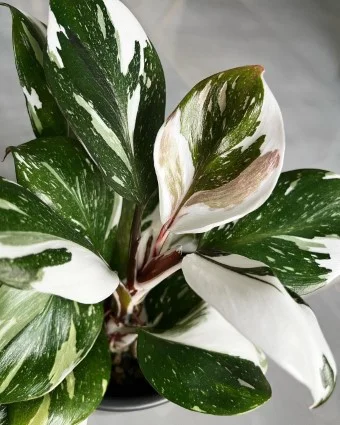

Propagation: Sharing the Majesty Through Stem Cuttings
Propagating your Philodendron White Knight through stem cuttings is a simple and rewarding way to multiply your collection or share this majestic plant with friends and family. Here’s a step-by-step guide to ensure successful propagation:
- Select a Healthy Stem: Look for a healthy, mature stem with at least two to three leaves and a node (a small bump or blemish on the stem where leaves, branches, or aerial roots grow). The health of the stem is crucial for successful propagation.
- Make the Cut: Using sterilized scissors or pruning shears, cut just below a node. The cutting should be about 4-6 inches long. Clean cuts prevent disease and encourage quicker recovery.
- Prepare the Cutting: Remove the lower leaves to expose the node. This area will be submerged in water.
- Rooting in Water: Place the cutting in a glass or jar of water, ensuring the node is submerged. Change the water every few days to keep it fresh and reduce the risk of bacterial growth. Place the jar in bright, indirect sunlight.
- Transplanting: Once roots develop and are a few inches long, usually within a few weeks, gently plant the cutting in well-draining soil in a pot. Water it thoroughly.
- Aftercare: Keep the soil moist but not waterlogged, and place the pot in bright, indirect sunlight. Your newly propagated Philodendron White Knight will need time to adjust and grow strong in its new environment.
!Propagating Philodendron White Knight Healthy stem cutting placed in water for rooting.
Benefits of Propagation:
- Economical Growth: Propagation is a cost-effective way to expand your plant collection or gift plants without purchasing new ones.
- Health Check: Taking cuttings encourages you to inspect and interact with your plant, promoting early detection of pests or diseases.
- Sharing Joy: Propagated plants make thoughtful, personal gifts that share the beauty and benefits of indoor gardening with others.
Propagating your Philodendron White Knight not only adds to your collection but also encourages a deeper connection with your plants. By following these steps, you’ll enjoy the process of nurturing new growth, sharing its beauty, and ensuring the longevity of this splendid variety.
Conclusion:
Caring for a Philodendron White Knight involves several key steps that ensure its health and vibrancy. First, ensure proper drainage to prevent root rot indicated by yellowing leaves. Maintain balanced moisture and avoid over-watering. Second, address the environmental needs by providing bright, indirect light and maintaining humidity to prevent brown tips on leaves. Adequate light also aids in preventing stunted growth, alongside regular pest inspections and proper fertilization. Remember, the unique variegated foliage of the Philodendron White Knight makes it a standout plant, enriching your space with its stunning beauty and dynamic growth patterns.
We’d love to hear from you! Share your experiences, tips, or any questions you have about caring for your Philodendron White Knight in the comments below. Whether it’s your success stories with propagation or tackling common issues, your contributions help foster a vibrant community of plant enthusiasts.
